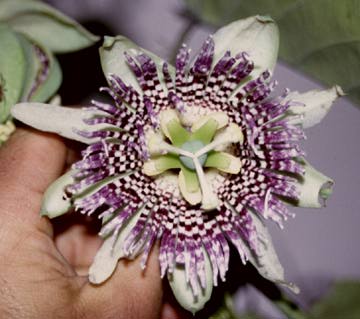
Passion flower (Passiflora sp.) from the Andes of Peru
© Thomas Carlson

Currently we are using U C Berkeley's Richard B. Gump South Pacific Research Station, on the island of Moorea in French Polynesia for teaching an undergraduate course "Biology and Geomorphology of Tropical Islands". This is an intensive whole semester 13 unit course, in which we plan to enhance the teaching of ethnobiology, in collaboration with the local French Polynesian people in the islands. The Polynesian culture is relatively intact on Moorea, with a thriving tradition of botanical medicine, despite a dwindling knowledge of the native resources. We will develop further courses in French Polynesia, at both the graduate and undergraduate level, focused on traditional knowledge, and research methods in ethnobiology, and develop further interactions with local educational and cultural organizations.
Current courses for graduate students related to biodiversity, ethnobiology, & medicine include: Medical Ethnobotany (Carlson); Complementary Medicine (Carlson & Mishler), Dietary Anthropology, Ecology of Hunter-Gathers, Conservation Biology (Milton); Principles of Phylogenetics: Ecology & Evolution (Mishler & Lindberg); Chemical Ecology, Food Toxicology (Kubo); Human Endocrinology, Endocrine Disruptors (Hayes); Infectious Disease Research in Developing Countries, Molecular Parasitology (Harris).
Research opportunities will also be available for both graduate and undergraduate Berkeley students in all the research efforts proposed.
We will undertake a major expansion of our web-based presentation of materials on ethnobiology of the Pacific Rim and other regions of he world. This will be a template that will be applied to a variety of additional geographical sites where we will conduct research. Educational programs will be given through the Herbaria, the Berkeley Natural History Museums, and Botanical Garden. Other outreach programs to local schools will be undertaken. For example, the Hayes lab has developed a program of K-12 outreach called TEAM OUT-REACH AND DEVELOPMENT (TOAD). Students in the lab visit local area schools with live exhibits to speak with students about bio-diversity, the importance of conservation and the importance of primary research. Tours of the laboratory and animal facilities are conducted for visiting K-12 students.